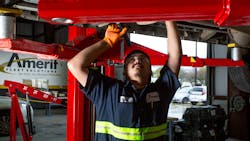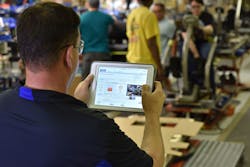Three steps to improve vehicle maintenance technicians' health and wellness
Every shop, whether they’re independent or work with a nationwide dealer, knows that their technicians are one of their most important assets. To keep them happy and healthy, each shop needs a safety program that can help technicians mitigate accidents and the toll that turning wrenches takes on the body. Even if a shop has a low incident rate, The Trucking Injury Reduction Emphasis (TIRES) initiative from the Washington State Department of Labor & Industries still found that the trucking industry has some of the highest costs and rates of injury. And The U.S. Bureau of Labor Statistics reported 38,350 transportation and warehousing workers lost days of work due to musculoskeletal disorders (MSDs) in 2018.
Read more: High- and low-tech ways to improve shop ergonomics
But while many fleet managers know the importance of preventing these kinds of injuries, they may be less clear on how to develop a program to do so. After speaking with environmental, health, and safety organizations as well as commercial vehicle groups, there are three main steps needed to establish a strong safety program: metrics, communication, and action.
1. Establish metrics
Whether large or small, a maintenance operation will never get a handle on their safety program if they don’t have a good way to measure how many injuries they’re experiencing, when they’re happening, and why.
“Throughout the year, we look at the highest categories of injuries and the root causes of those injuries specifically,” said Amy Lawson, assistant vice president, EHS and security, Amerit Fleet Solutions. “And then we try to deal with those.”
To do this, fleets can use programs such as the VelocityEHS Accelerate platform. Produced by VelocityEHS, a company that offers AI-powered ESG and EHS software, the platform allows organizations to track their ergonomics practices and processes and see where their workers are most at risk.
“It’s able to take a look at what their primary injury causes are, like product design, process flow or design, equipment or tool design, or workstation layout,” said Kristi Hames, senior solutions strategist, industrial hygiene, VelocityEHS. “Workstation layout and equipment and tool design are probably the most common direct causes of injury that we've seen with a lot of our customers.”
But even without a full suite such as the Accelerate platform, smaller shops can still track their work-related injuries and compensation to direct their efforts, as Black’s Tire and Auto Service does.
“We look at the prior year’s history and how many work-related injuries we are reporting,” said Benjie Greene, commercial director, Black’s Tire and Auto Services. “Our first main metric is to make sure that we see that number trending downward as opposed to upward.”
2. Set up communication channels
Similar to how telematics data must be shared among a fleet, once a shop has begun collecting their safety data, the next step is to make sure that information is disseminated properly and consistently refreshed. Sometimes a shop’s insurance company can help facilitate this communication, other times, fleets may choose to keep their communication in-house.
“The insurance company that we use for our workers comp is very proactive with us,” Greene explained. “They come through and do quarterly reviews on some of our facilities and they'll come back and report their findings to our management team.”
These findings include places where Black’s Tire and Auto Service could improve on their safety, or if there are any particularly concerning processes that put technicians at risk.
Meanwhile, Amerit Fleet Solutions not only shares their injury statistics among their managers, but also their technicians.
“We feel they have a right to know and understand what those risks are,” Lawson noted. “And by doing that, we also are able to gain their input.”
This input comes in the form of Amerit Fleet Solutions’ electronic hazard reporting system, where the company’s technicians can enter any concerns, ideas, or thoughts on safety and know that it will reach their manager and Lawson’s corporate team. Managers can then respond in the system, too, allowing for an open dialogue.
“It's a great way to get feedback from the field,” Lawson observed. “Because we feel like the technicians really are the experts and the people that know what works and what doesn't for them.”
3. Take action
Finally, shops and fleets need to act on the data and input they gather from their technicians. While there is no ‘silver bullet’ method to ensuring safety, there’s a wide variety of tactics shops can utilize, ranging from a weekly safety huddle to a modifying the shop istelf.
“Many times, we will reorganize a shop because we feel that it could be more efficient and safer,” Greene said. “If we had certain tasks isolated to different areas of the building, then we will actually remodel our shop just to make sure that we're improving our efficiency.”
Meanwhile, Amerit Fleet Solutions holds bi-weekly calls with its leaders solely to discuss safety and injury prevention, which can lead to increased training on body mechanics or technician-manager discussions to ensure all employees know the safest way a job could be performed. In others, these discussions result in company policies to further ensure safety.
Read more: Lifts raise bar for ergonomics in the shop“We have policies in place such as lifting restrictions on the amount of weight that people should be lifting by themselves before they should ask for help or involve assist devices,” Lawson commented.
For any of these safety solutions, from training to procuring assistive technology, it’s important that shops follow up to make sure they’re being implemented properly and having the impact they should. With a platform like VelocityEHS Accelerate, this means shops can track which safety assessments and trainings have been completed by individual technicians, the number of physical improvements in place, and whether these improvements have been reassessed later.
Through these follow-ups, “you can track your overall risk reduction within a company or within a certain facility,” Hames noted.
Overall, this allows fleets to gauge the risk in a particular facility, depending on where training or solutions has been implemented, all with the goal of increasing technician safety.
“One of the biggest things that we emphasize over and over with our employees is to stop work if they are not able to do it safely,” Lawson said.
About the Author

Alex Keenan
Alex Keenan is an Associate Editor for Fleet Maintenance magazine. She has written on a variety of topics for the past several years and recently joined the transportation industry, reviewing content covering technician challenges and breaking industry news. She holds a bachelor's degree in English from Colorado State University in Fort Collins, Colorado.

